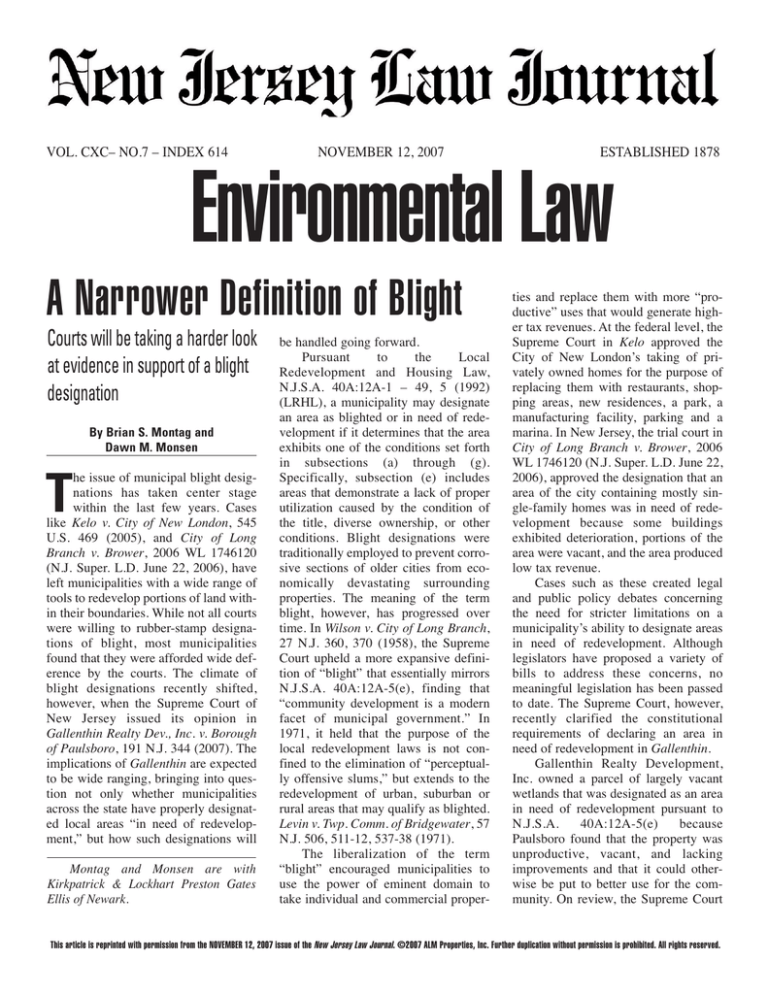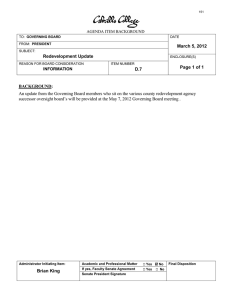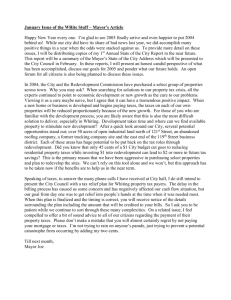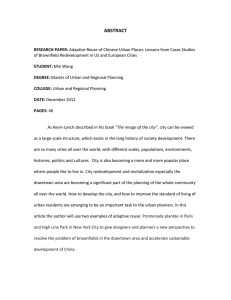
VOL. CXC– NO.7 – INDEX 614
NOVEMBER 12, 2007
ESTABLISHED 1878
Environmental Law
A Narrower Definition of Blight
Courts will be taking a harder look
at evidence in support of a blight
designation
By Brian S. Montag and
Dawn M. Monsen
he issue of municipal blight designations has taken center stage
within the last few years. Cases
like Kelo v. City of New London, 545
U.S. 469 (2005), and City of Long
Branch v. Brower, 2006 WL 1746120
(N.J. Super. L.D. June 22, 2006), have
left municipalities with a wide range of
tools to redevelop portions of land within their boundaries. While not all courts
were willing to rubber-stamp designations of blight, most municipalities
found that they were afforded wide deference by the courts. The climate of
blight designations recently shifted,
however, when the Supreme Court of
New Jersey issued its opinion in
Gallenthin Realty Dev., Inc. v. Borough
of Paulsboro, 191 N.J. 344 (2007). The
implications of Gallenthin are expected
to be wide ranging, bringing into question not only whether municipalities
across the state have properly designated local areas “in need of redevelopment,” but how such designations will
T
Montag and Monsen are with
Kirkpatrick & Lockhart Preston Gates
Ellis of Newark.
be handled going forward.
Pursuant
to
the
Local
Redevelopment and Housing Law,
N.J.S.A. 40A:12A-1 – 49, 5 (1992)
(LRHL), a municipality may designate
an area as blighted or in need of redevelopment if it determines that the area
exhibits one of the conditions set forth
in subsections (a) through (g).
Specifically, subsection (e) includes
areas that demonstrate a lack of proper
utilization caused by the condition of
the title, diverse ownership, or other
conditions. Blight designations were
traditionally employed to prevent corrosive sections of older cities from economically devastating surrounding
properties. The meaning of the term
blight, however, has progressed over
time. In Wilson v. City of Long Branch,
27 N.J. 360, 370 (1958), the Supreme
Court upheld a more expansive definition of “blight” that essentially mirrors
N.J.S.A. 40A:12A-5(e), finding that
“community development is a modern
facet of municipal government.” In
1971, it held that the purpose of the
local redevelopment laws is not confined to the elimination of “perceptually offensive slums,” but extends to the
redevelopment of urban, suburban or
rural areas that may qualify as blighted.
Levin v. Twp. Comm. of Bridgewater, 57
N.J. 506, 511-12, 537-38 (1971).
The liberalization of the term
“blight” encouraged municipalities to
use the power of eminent domain to
take individual and commercial proper-
ties and replace them with more “productive” uses that would generate higher tax revenues. At the federal level, the
Supreme Court in Kelo approved the
City of New London’s taking of privately owned homes for the purpose of
replacing them with restaurants, shopping areas, new residences, a park, a
manufacturing facility, parking and a
marina. In New Jersey, the trial court in
City of Long Branch v. Brower, 2006
WL 1746120 (N.J. Super. L.D. June 22,
2006), approved the designation that an
area of the city containing mostly single-family homes was in need of redevelopment because some buildings
exhibited deterioration, portions of the
area were vacant, and the area produced
low tax revenue.
Cases such as these created legal
and public policy debates concerning
the need for stricter limitations on a
municipality’s ability to designate areas
in need of redevelopment. Although
legislators have proposed a variety of
bills to address these concerns, no
meaningful legislation has been passed
to date. The Supreme Court, however,
recently clarified the constitutional
requirements of declaring an area in
need of redevelopment in Gallenthin.
Gallenthin Realty Development,
Inc. owned a parcel of largely vacant
wetlands that was designated as an area
in need of redevelopment pursuant to
N.J.S.A.
40A:12A-5(e)
because
Paulsboro found that the property was
unproductive, vacant, and lacking
improvements and that it could otherwise be put to better use for the community. On review, the Supreme Court
This article is reprinted with permission from the NOVEMBER 12, 2007 issue of the New Jersey Law Journal. ©2007 ALM Properties, Inc. Further duplication without permission is prohibited. All rights reserved.
2
NEW JERSEY LAW JOURNAL, NOVEMBER 12, 2007
outlined the evolution of the term
blight, and noted that although the
meaning of blight has evolved overtime, the term retains its essential negative connotation. In clarifying the current meaning of the term, the Court stated that:
We need not examine every
shade of gray coloring a concept as elusive as “blight” to
conclude that the term’s meaning cannot extend as far as
Paulsboro contends. At its
core, “blight” includes deterioration or stagnation that has a
decedent effect on surrounding
property … Paulsboro’s interpretation … which would
equate “blighted areas” to
areas that are not operated in an
optimal manner, cannot be reconciled with the New Jersey
Constitution.
With regard to N.J.S.A. 40A:12A5(e), the Court held that “[t]he phrase
‘other conditions’ is not a universal
catch-all that refers to any eventuality.”
Rather, subsection (e) applies only in
areas that are not susceptible to unified
development because of diversity of
ownership or conditions of title issues.
Finally, the Court explained that municipalities “must establish a record that
contains more than a bland recitation of
applicable statutory criteria and a declaration that those criteria are met,” and
the net opinion of a single expert is not
enough upon which a designation can
stand.
After Gallenthin was handed down,
lower courts struck down a number of
municipal blight designations. These
decisions not only impacted the municipalities involved, but also the developers who had invested in the designated
areas. The following is a discussion of
the implications of Gallenthin on
municipalities and developers going
forward.
The primary impact of Gallenthin
is that municipalities may no longer
declare an area blighted pursuant to
N.J.S.A. 40A:12A-5(e) because the
area is not fully productive. That provision only applies to areas that are not
susceptible to unified development
because of diversity of ownership or
conditions of title issues.
Gallenthin also stressed that
municipalities must support their blight
designations with substantial evidence.
Although this has long been a statutory
requirement, the inference is that the
courts will be taking a harder look at the
evidence a municipality presents in support of a designation. The Court clarified that a municipality’s record must
contain “more than a bland recitation of
applicable statutory criteria and a declaration that those criteria are met.” The
Court also emphasized that if a municipality is going to include a nonblighted
property within a designated area in
need of redevelopment, the record must
contain evidence that the property is
integral and necessary to the larger
redevelopment plan or area.
To meet the standard of substantial
evidence, municipalities must undertake
such tasks as examining building permits, code violations, variance applications, private market transactions, tax
arrears, occupancy rates and the presence of criminal complaints. Mulberry
St. Area Prop. Owner’s Group v. City of
Newark, No. ESX-L-9916-04 (Law Div.
July 19, 2007) (slip op. at 64). They may
also need to inspect the interior of buildings and study the revenue of municipal
taxes generated in the area. Once a
municipality gathers this information, it
must then analyze whether the data supports a determination of blight. In addition to these tasks, Gallenthin suggests
that a municipality may also need to
consider the environmental benefits a
property offers. There, the Court criticized Paulsboro for failing to consider
the benefits of the wetlands located on
the property and the harvesting of
phragmites that occurred on the property. A municipality may need to balance
the detrimental elements of the property
against the environmental benefits contained therein.
Gallenthin may also impact the
190 N.J.L.J. 614
timing within which a municipality may
be required to defend its designation. In
Evans v. Township of Maplewood, No.
ESX-L-6910-06 (Law Div. July 27,
2007) (slip op. at 3), the township
opposed an action in lieu of prerogative
writ on the grounds of ripeness and
standing because although there was a
designation of blight, no development
plan was in place. In finding that the
plaintiffs did have standing, the court
noted that “Gallenthin is itself evidence
that a designation as an area in need of
redevelopment is justiciable and that an
attack on it is not premature.”
In addition to municipalities and
property owners, developers are another faction that might be affected by the
Gallenthin decision. Developers, for
example, may be dissuaded from participating in municipal redevelopment
projects because, in the aftermath of
Gallenthin, courts have disapproved
designations of blight, and in doing so,
pulled the plug on redevelopment projects already underway.
Those developers who continue to
participate in redevelopment projects
will likely attempt to ensure that municipalities follow proper procedures in
declaring an area in need of redevelopment. Most significantly, the developer
will presumably take a more active role
to ensure that municipalities conduct
thorough investigations of an area prior
to designating it blighted. A proper
investigation will include such tasks as
delineated above, including examining
permits and occupancy rates, inspecting
buildings, determining tax revenue and
considering environmental benefits.
Without question, Gallenthin is
viewed as a set-back to municipal redevelopment projects. The decision, however, did not overturn the LRHL or
restrict the ability of municipalities to
declare an area in need of redevelopment pursuant to subsections (a), (b),
(c), (d), (f), or (g) of N.J.S.A. 40A:12A5. Under subsection (e), a property may
be declared blighted if it exhibits disjointed development as a result of diversity of ownership or conditions of title
issues. As municipalities conduct more
190 N.J.L.J. 614
NEW JERSEY LAW JOURNAL, NOVEMBER 12, 2007
thorough investigations prior to
declaring an area in need of redevelopment, consistent with N.J.S.A.
40A:12A-6, it should arguably result
in more substantive due process rights
and certainty to all parties involved.
After maintaining a liberal connotation of “blight” for many years, the
Supreme Court’s Gallenthin decision
has narrowed the interpretation and
meaning of the term. One of the primary implications of the Court’s decision is that an area may no longer be
declared blighted — or in need of
redevelopment — merely because it is
not fully productive; moreover,
municipalities must now undertake
more complete and thorough investigations prior to designating an area in
need of redevelopment, and develop-
3
ers will likely play a greater role in
attempting to create an appropriate
record to support any such decision. It
remains to be seen whether the
Legislature will still step in to further
define the meaning of blight, but,
without question, future local redevelopment, public policy debate and case
law will continue to shape the topic
for some time to come. I






